What Is the Great Decoupling?
The Great Decoupling in SEO (or “The Great Decoupling of Google Search”) refers to the separation of search impressions and click through rates (CTR). Specifically, impressions are rising while click through rates remain stagnant or are dropping.
This trend is being driven by the rise of scraper bots and generative KI systems, such as Google’s AI Overviews.
Impressions and click through rates (CTR) are two key SEO metrics that indicate how well your site performs on search results pages. To be specific:
- Impressions refer to the number of times your page appears in the search results page
- Click through rate (CTR) shows the percentage of users who click on your link on the search results page
Previously, click through rates and impressions were closely correlated. When one rises, the other rises, and when one falls, the other falls. So, a site with a high impression will typically have a similarly high click through rate, while one with low impressions will generally have a low click through rate.
However, this is no longer the case as impressions and click through rates no longer correlate. This means it is now common for a webpage to have a high impression but a low click through rate.
Bloggers and SEOs refer to this as the great decoupling, that is, the decoupling (separation) of search impressions and click through rates.
While the great decoupling is typically associated with Google, due to Google’s dominance in the search engine space, it has also been observed on the Bing search engine, where it is caused by scraper bots and Microsoft’s Copilot.
In this article, we’ll cover:
How the Great Decoupling Got Its Name
The name “The Great Decoupling” was first suggested by Santos Darwin on X (formerly Twitter). Darwin made this suggestion after Gagan Ghotra shared an image showing the split between clicks and impressions.
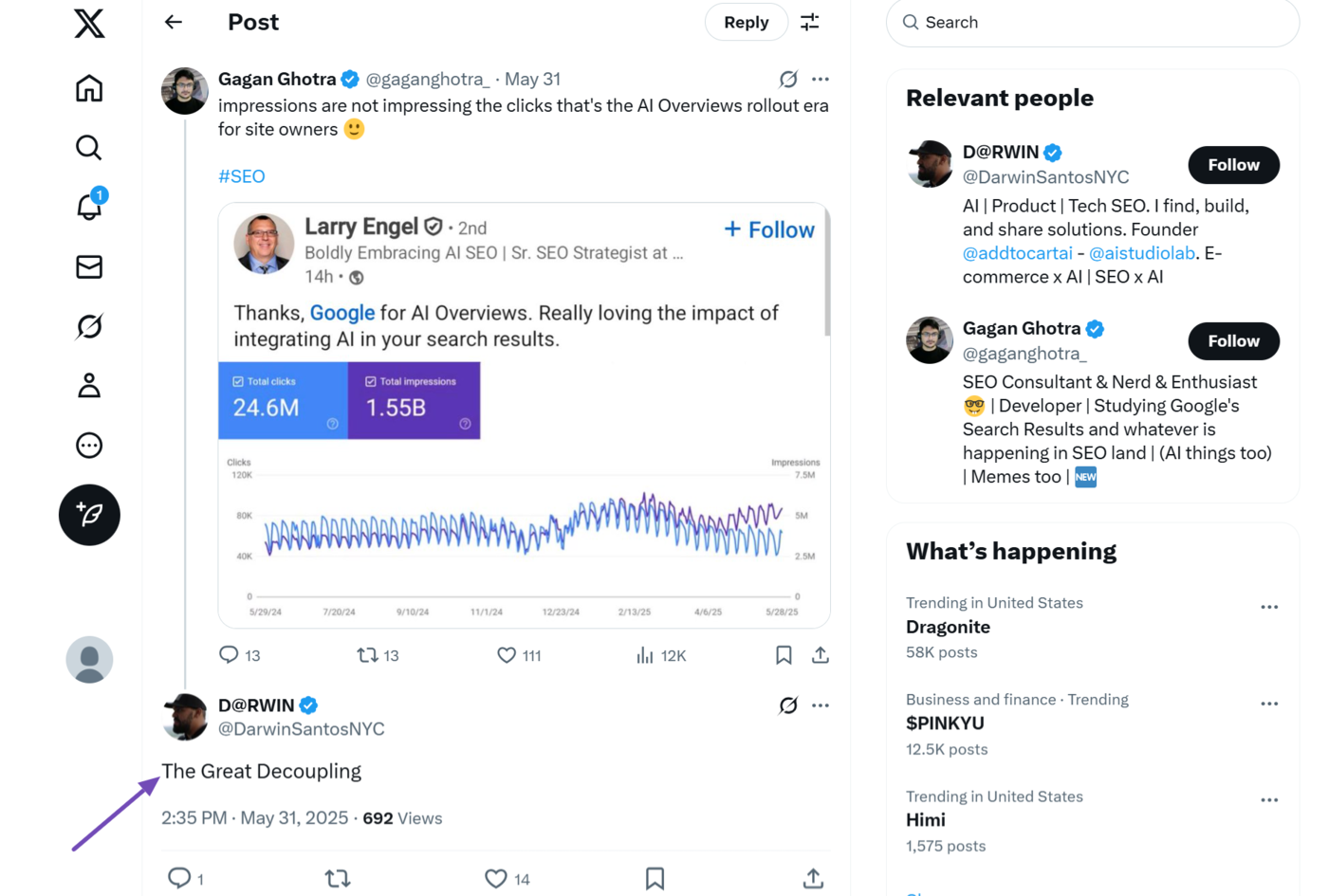
As it stands, the name is not a fad term and has even been acknowledged by Martin Splitt of the Google Search Central team, who confirmed the split between impressions and click through rates during a June 16, 2025, Google Search Central event held in Warsaw, Poland.
Why the Great Decoupling Is Happening
The great decoupling has been linked to two factors:
- The rise of generative AI systems on search results pages
- An increase in the number of scraper bots on the web
Let us examine how both factors contribute to the great decoupling.
1 How Generative AI Contributes to the Great Decoupling
Generative AI systems, such as Microsoft’s Copilot, Google’s AI Overviews, and AI Mode, have a significant effect on the great decoupling.
All three features provide AI-generated responses to visitors right on the search results page. For instance, this is one of the multiple ways AI Overviews can appear on Google results pages:
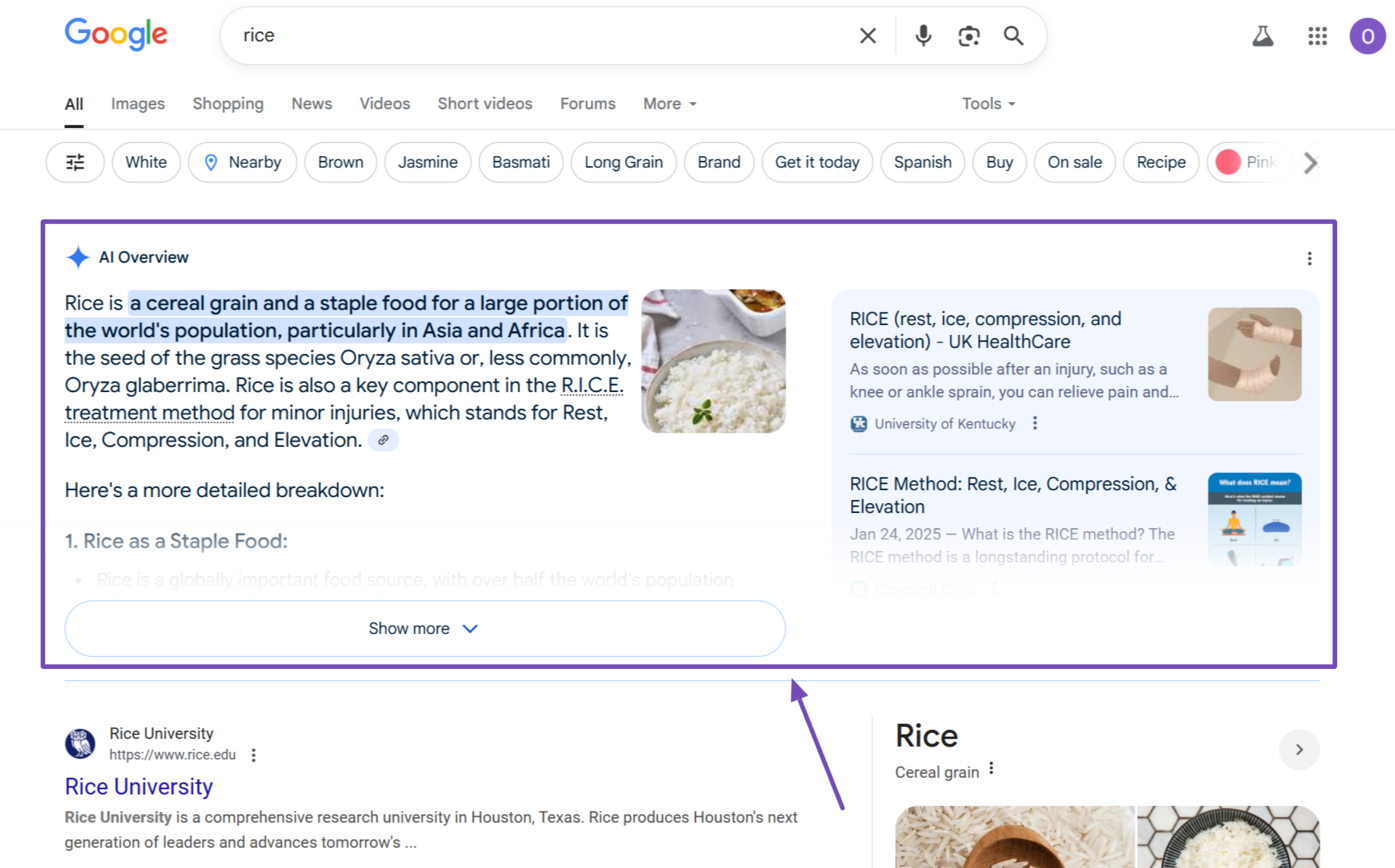
Similarly, this is how Copilot appears on Bing results pages:
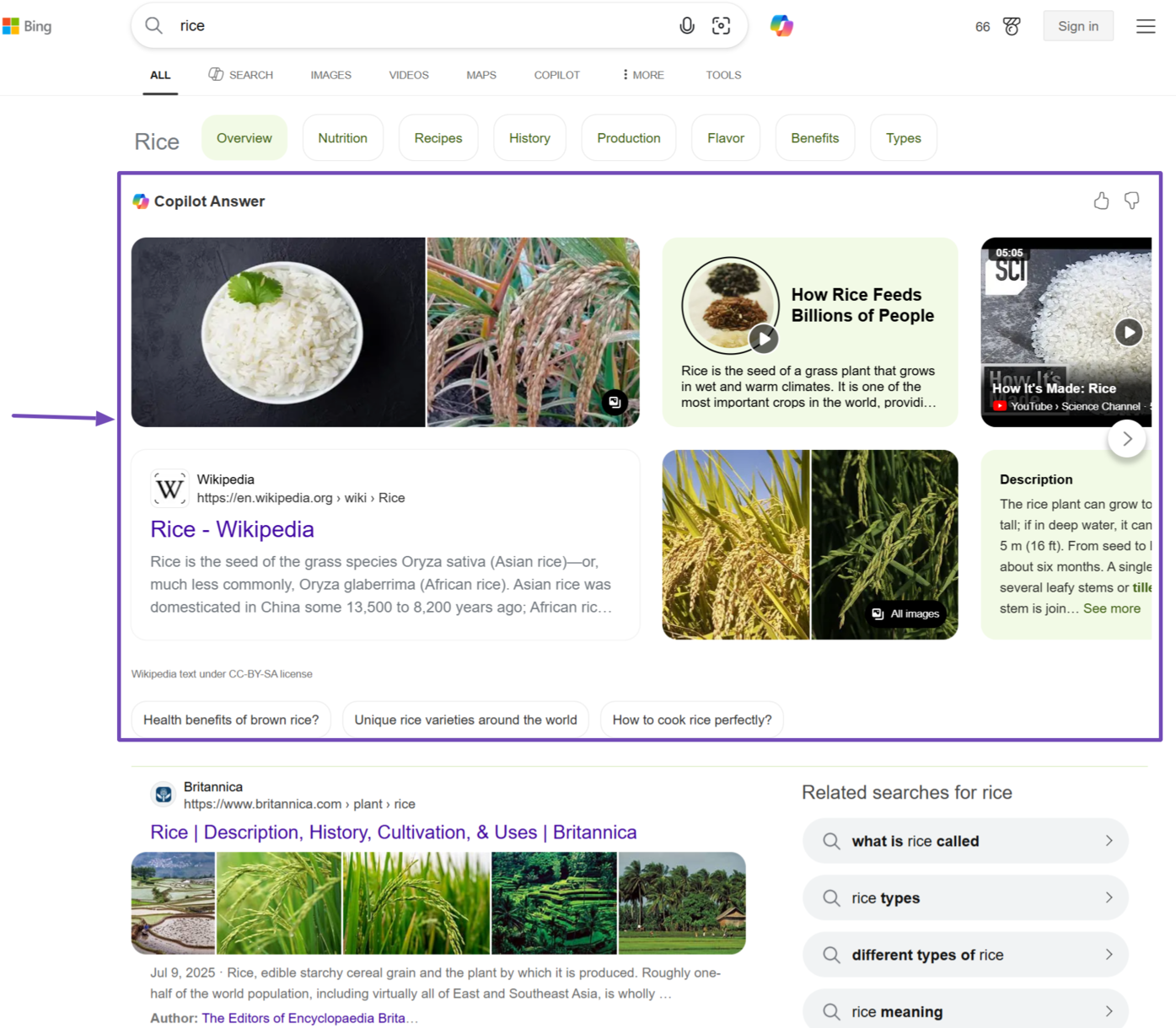
These AI-generated answers typically contain comprehensive content that answers the visitor’s query, just like a regular webpage. So, visitors just access them without bothering to visit the webpages.
This means the webpages displayed on the search results page are no longer being clicked as they used to be. So, such webpages have a high impression since they are shown to users, but a low click through rate since fewer users are clicking.
2 How Scraper Bots Contribute to the Great Decoupling
The great decoupling has also been attributed to the rise of scraper bots on the web. These scraper bots are used by SEO and AI tools to search the web and return data or AI-generated responses to their users.
These bots typically include a &num=100 URL parameter to their Google searches. In response, Google returned 100 results on the search results pages instead of the typical 10.
Now, scraper bots used the &num=100 parameter to reduce the number of Google searches they made. Without it, they would have to run ten individual searches to achieve the same results as they would have with a single search containing the &num=100 parameter.
However, for bloggers, this meant that many webpages, particularly those that appeared anywhere between pages 2 and 10, were receiving more impressions than they would have received if the search was done without the &num=100 parameter.
Curiously, the effect of scraper bots on the great decoupling only became obvious when Google ended support for the &num=100 parameter in September 2025.
When that happened, the gap between clicks and impressions narrowed as multiple sites lost the impressions they had previously earned from the scraper bots.
However, this gap did not completely close, and scraper bots still have an effect on the great decoupling. This gap is expected to increase as scraper bots adjust to Google’s end of support for the &num=100 parameter.
How AI Overviews Impact the Great Decoupling
The great decoupling is most prevalent on Google, and AI Overviews, formerly known as Search Generative Experience (SGE), has been blamed as the major cause.
AI Overviews can be comprehensive and cover the query in depth, just as a regular webpage would. Therefore, a user can access the required response from AI Overviews without needing to click on any webpage on the search results page.
AI Overviews itself can appear at various locations on the search results page, including the Knowledge Panel und das Die Leute fragen auch. Sometimes, it even displays links that send visitors to another Google results page.
For example, when we searched for “rice,” the AI Overview area of the search results page contains multiple links about the different types of rice. However, when we click on one of those links, it opens a new Google search results page.
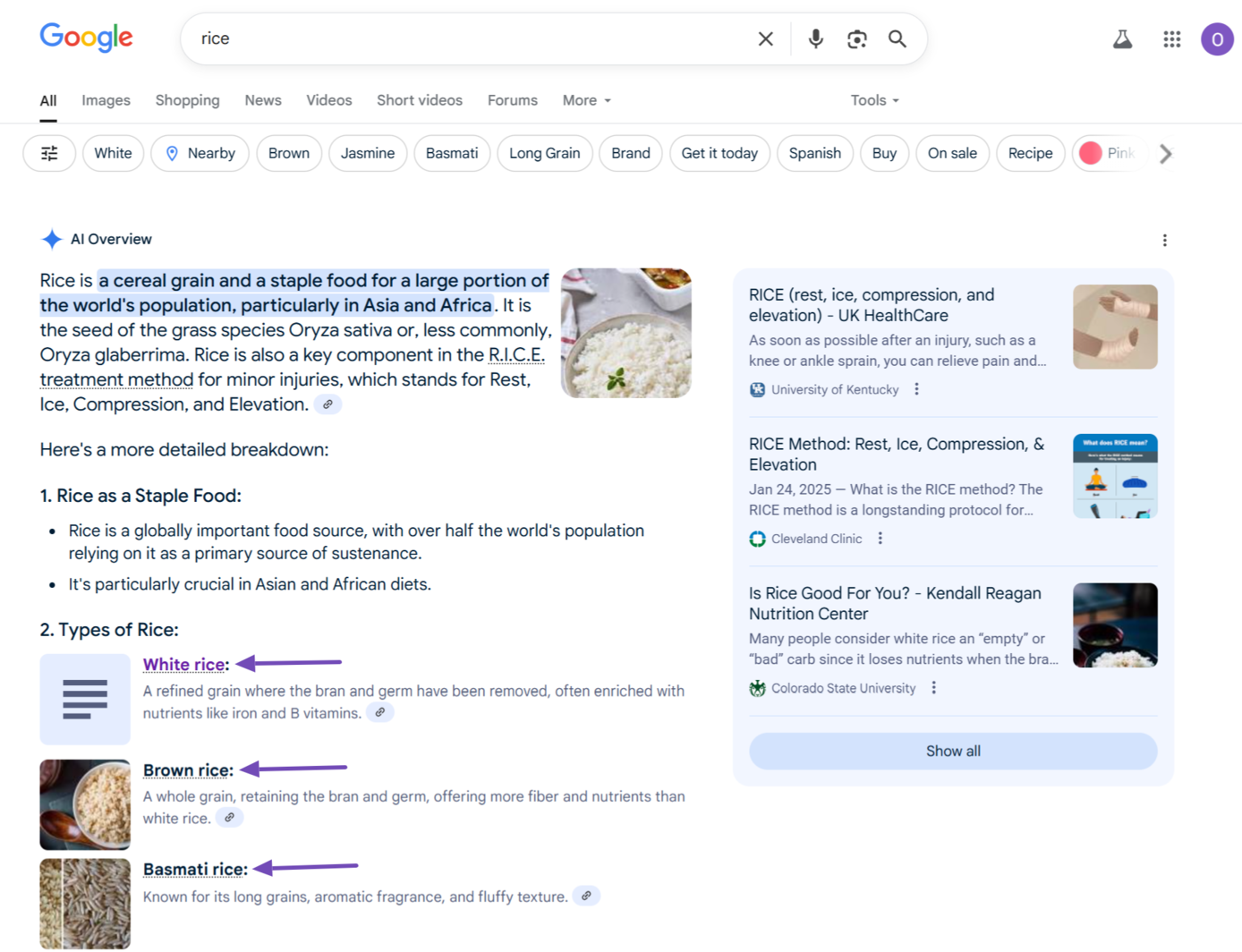
All these mean AI Overviews can keep visitors on Google results pages for longer, which translates to fewer clicks and traffic to the pages that appear on the search results page.
There is also no indication that it will go away anytime soon. If anything, AI-generated results are predicted to be the future of search.
Google has even introduced a new AI Mode feature, which is more comprehensive and is likely to divert more traffic away from bloggers than the AI Overview feature.
With that said, it is crucial to note that the great decoupling is most evident on results pages for top of the funnel (TOFU) keywords. In contrast, much of middle of the funnel (MOFU) content results pages do not always return AI Overviews, and bottom of the funnel (BOFU) content results pages seldom do.
This means bloggers will see less variation in their impressions and click through rate, the lower down they go in their sales funnel.
How Scraper Bots Impact the Great Decoupling
Scraper bots continue to have an impact on the great decoupling.
While less considerable than it was before Google ended support for the &num=100 parameter, the effect remains substantial and can even become more significant once scraper bots adjust to Google’s end of support for the parameter.
One suggested workaround is that scraper bots may begin running multiple searches. So, instead of just one search, as they did with the &num=100 parameter, they can run ten using the &start parameter to achieve the same results.
This means that many sites will continue to receive excessive impressions and low clicks, which will further compound the great decoupling problem.
In all, while ending support for the &num=100 parameter has reduced the effect of the great decoupling, its effect is temporary, and scraper tools will likely adjust and find other methods to get all the pages that they need.
How to Optimize for the Great Decoupling
The great decoupling is a huge concern for bloggers. Their content keeps appearing and ranking on search results pages. However, visitors are not clicking, which means they are not getting the maximum results for their SEO efforts.
At the same time, optimizing for the great decoupling is crucial as generative AI is predicted to be the future of SEO. So, bloggers are already exploring various methods to navigate around it and mitigate its impact on their traffic, conversions, and revenue.
1 Move down the Funnel
One great strategy to beat the great decoupling is to move lower down the funnel. That is, you should pay more attention to ranking for middle of the funnel (MOFU) and bottom of the funnel (BOFU) content, especially those that do not have AI Overviews.
To improve your chances of getting clicks, you should focus on creating and ranking for middle of the funnel content keywords as they are the closest to the top of the funnel content, and can get your content in front of visitors who require your product or service.
2 Pay Attention to Other Metrics
Bloggers should also pay attention to metrics other than the click through rate. While a drop in the click through rate translates to a drop in conversions, some content may still enjoy decent conversions.
In such cases, content with high impressions, low click through rates, but still converts traffic into subscribers or revenue, is relevant and useful to the site. So, bloggers should continue to improve and maintain such content.
3 Optimize for Generative AI
The rise of AI Overviews and AI Mode on Google, and Copilot on Bing correlates with the rise of other generative AI chatbots, such as Zwillinge und ChatGPT, as well as generative AI search engines like Perplexity AI.
These platforms can search the web like a regular search engine, and some, including ChatGPT and Perplexity, are creating AI-powered browsers. This means they are likely to become more dominant in the search space.
These generative AI systems also sometimes display relevant webpages and links alongside their AI-generated responses. For example, ChatGPT included these links in its response.
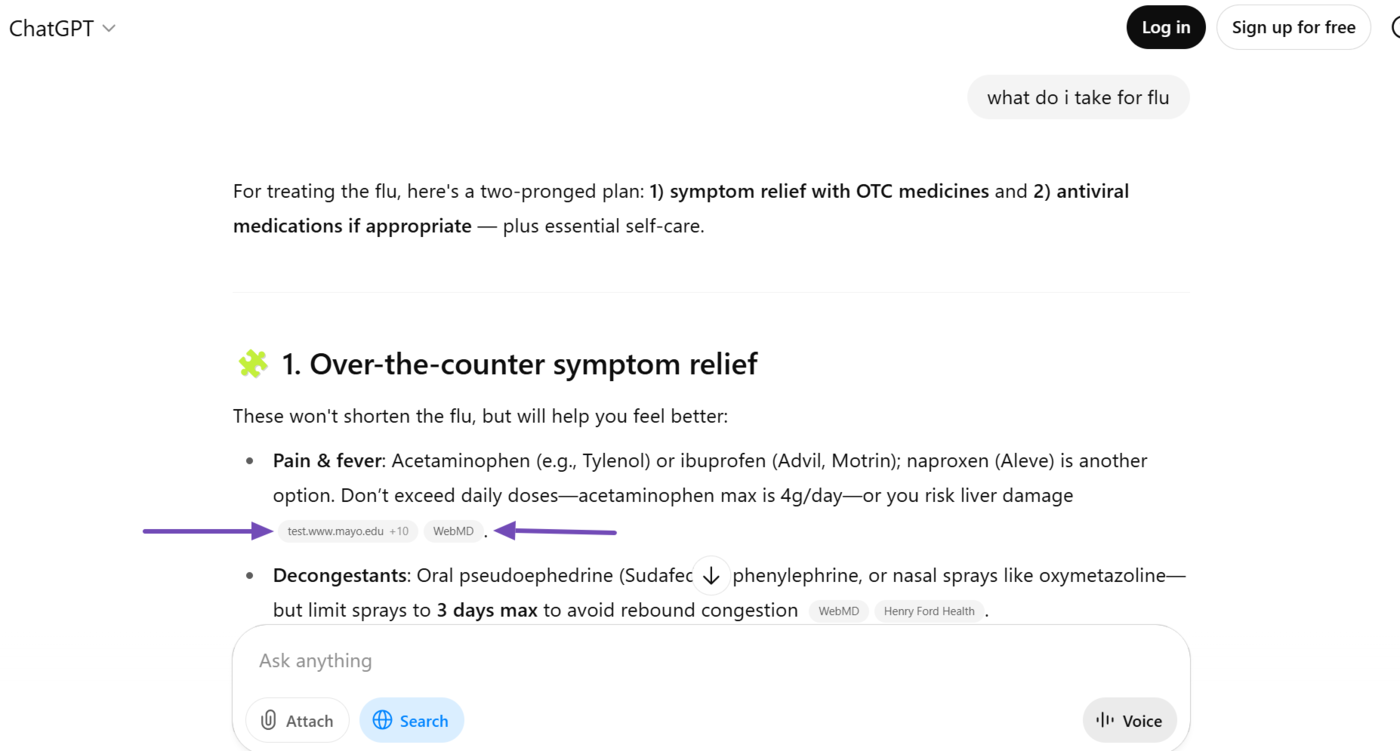
This has led to the rise of Generative AI Optimization (GEO), which refers to the process of optimizing your content for generative AI systems. This increases the chances of getting your content featured alongside the other webpages returned with the AI-generated response.
However, note that Generative AI Optimization (GEO) is not an agreed-upon term and is also known by other names, including AI optimization (AIO), large language model optimization (LLMO), generative AI SEO (GenAI SEO), and large language model SEO (LLM SEO).
4 Consider Other Marketing Channels
Another technique is to consider other sources of traffic and reduce your reliance on Google. This is particularly important for bloggers and businesses that completely rely on Google for traffic.
This step is crucial as AI Overviews is just another Google feature taking traffic away from bloggers. Google offers additional features, including the Knowledge Panel, Featured Snippets, and People Also Ask, which display information directly on the search results page.
These systems have been blamed for zero-click searches, which occur when visitors do not click on any webpage on the search results page because Google has already shown them an answer. Then there are the never-ending Google updates that bloggers and businesses continually accuse of taking away their traffic.
The great decoupling itself is expected to become more severe as Google releases AI Mode, which is a more comprehensive AI-powered system than AI Overviews. Therefore, instead of relying solely on Google, you can explore other traffic sources, such as paid advertising and email marketing.